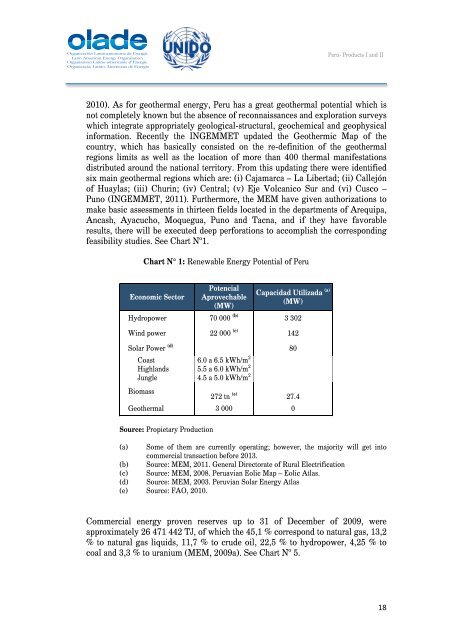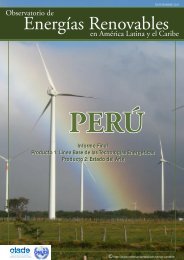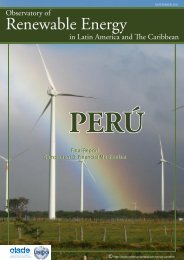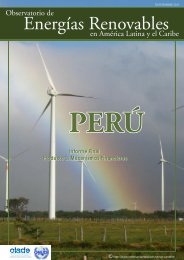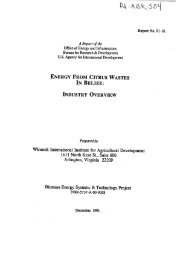PERÃ - Observatory for Renewable Energy in Latin America and
PERÃ - Observatory for Renewable Energy in Latin America and
PERÃ - Observatory for Renewable Energy in Latin America and
Create successful ePaper yourself
Turn your PDF publications into a flip-book with our unique Google optimized e-Paper software.
<br />
Perú- Products I <strong>and</strong> II<br />
<br />
2010). As <strong>for</strong> geothermal energy, Peru has a great geothermal potential which is<br />
not completely known but the absence of reconnaissances <strong>and</strong> exploration surveys<br />
which <strong>in</strong>tegrate appropriately geological-structural, geochemical <strong>and</strong> geophysical<br />
<strong>in</strong><strong>for</strong>mation. Recently the INGEMMET updated the Geothermic Map of the<br />
country, which has basically consisted on the re-def<strong>in</strong>ition of the geothermal<br />
regions limits as well as the location of more than 400 thermal manifestations<br />
distributed around the national territory. From this updat<strong>in</strong>g there were identified<br />
six ma<strong>in</strong> geothermal regions which are: (i) Cajamarca – La Libertad; (ii) Callejón<br />
of Huaylas; (iii) Chur<strong>in</strong>; (iv) Central; (v) Eje Volcanico Sur <strong>and</strong> (vi) Cusco –<br />
Puno (INGEMMET, 2011). Furthermore, the MEM have given authorizations to<br />
make basic assessments <strong>in</strong> thirteen fields located <strong>in</strong> the departments of Arequipa,<br />
Ancash, Ayacucho, Moquegua, Puno <strong>and</strong> Tacna, <strong>and</strong> if they have favorable<br />
results, there will be executed deep per<strong>for</strong>ations to accomplish the correspond<strong>in</strong>g<br />
feasibility studies. See Chart Nº1.<br />
Chart N° 1: <strong>Renewable</strong> <strong>Energy</strong> Potential of Peru<br />
Economic Sector<br />
Potencial<br />
Aprovechable<br />
(MW)<br />
Capacidad Utilizada (a)<br />
(MW)<br />
Hydropower 70 000 (b) 3 302<br />
W<strong>in</strong>d power 22 000 (c) 142<br />
Solar Power (d) 80<br />
Coast 6.0 a 6.5 kWh/m 2<br />
Highl<strong>and</strong>s 5.5 a 6.0 kWh/m 2<br />
Jungle 4.5 a 5.0 kWh/m 2<br />
Biomass<br />
272 tn (e) 27.4<br />
Geothermal 3 000 0<br />
Source: Propietary Production<br />
(a) Some of them are currently operat<strong>in</strong>g; however, the majority will get <strong>in</strong>to<br />
commercial transaction be<strong>for</strong>e 2013.<br />
(b) Source: MEM, 2011. General Directorate of Rural Electrification<br />
(c) Source: MEM, 2008. Peruavian Eolic Map – Eolic Atlas.<br />
(d) Source: MEM, 2003. Peruvian Solar <strong>Energy</strong> Atlas<br />
(e) Source: FAO, 2010.<br />
Commercial energy proven reserves up to 31 of December of 2009, were<br />
approximately 26 471 442 TJ, of which the 45,1 % correspond to natural gas, 13,2<br />
% to natural gas liquids, 11,7 % to crude oil, 22,5 % to hydropower, 4,25 % to<br />
coal <strong>and</strong> 3,3 % to uranium (MEM, 2009a). See Chart Nº 5.<br />
18


